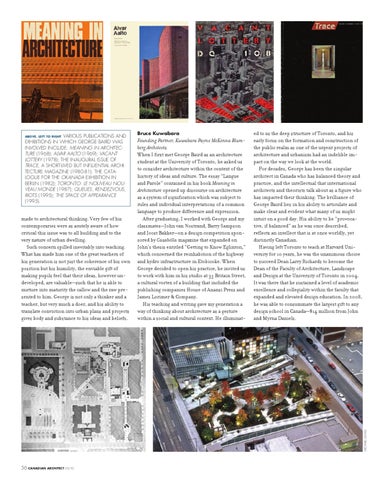vArious puBliCAtioNs ANd exhiBitioNs iN whiCh GeorGe BAird wAs iNvolved iNClude: Meaning in architecture (1968); alvar aalto (1969); vacant lottery (1978); the iNAuGurAl issue of trace, A short-lived But iNflueNtiAl ArChiteCture mAGAziNe (1980-81); the CAtAloGue for the oKanada exhiBitioN iN BerliN (1982); toronto: le nouveau nouveau Monde (1987); Queues, rendezvous, riots (1995); the space of appearance (1995). aBOve, left tO riGht
Founding Partner, Kuwabara Payne McKenna Blumberg Architects When I first met George Baird as an architecture student at the University of Toronto, he asked us to consider architecture within the context of the history of ideas and culture. The essay “Langue and Parole” contained in his book Meaning in Architecture opened up discourse on architecture as a system of signification which was subject to rules and individual interpretations of a common language to produce difference and expression. After graduating, I worked with George and my classmates—John van Nostrand, Barry Sampson and Joost Bakker—on a design competition sponsored by Casabella magazine that expanded on John’s thesis entitled “Getting to Know Eglinton,” which concerned the reinhabition of the highway and hydro infrastructure in Etobicoke. When George decided to open his practice, he invited us to work with him in his studio at 35 Britain Street, a cultural vortex of a building that included the publishing companies House of Anansi Press and James Lorimer & Company. His teaching and writing gave my generation a way of thinking about architecture as a gesture within a social and cultural context. He illuminat-
ed to us the deep structure of Toronto, and his early focus on the formation and construction of the public realm as one of the urgent projects of architecture and urbanism had an indelible impact on the way we look at the world. For decades, George has been the singular architect in Canada who has balanced theory and practice, and the intellectual that international architects and theorists talk about as a figure who has impacted their thinking. The brilliance of George Baird lies in his ability to articulate and make clear and evident what many of us might intuit on a good day. His ability to be “provocative, if balanced” as he was once described, reflects an intellect that is at once worldly, yet distinctly Canadian. Having left Toronto to teach at Harvard University for 10 years, he was the unanimous choice to succeed Dean Larry Richards to become the Dean of the Faculty of Architecture, Landscape and Design at the University of Toronto in 2004. It was there that he sustained a level of academic excellence and collegiality within the faculty that expanded and elevated design education. In 2008, he was able to consummate the largest gift to any design school in Canada—$14 million from John and Myrna Daniels.
miChAel AwAd
made to architectural thinking. Very few of his contemporaries were as acutely aware of how critical this issue was to all building and to the very nature of urban dwelling. Such concern spilled inevitably into teaching. What has made him one of the great teachers of his generation is not just the coherence of his own position but his humility, the enviable gift of making pupils feel that their ideas, however undeveloped, are valuable—such that he is able to nurture into maturity the callow and the raw presented to him. George is not only a thinker and a teacher, but very much a doer, and his ability to translate conviction into urban plans and projects gives body and substance to his ideas and beliefs.
Bruce Kuwabara
56 canadian architect 05/10
